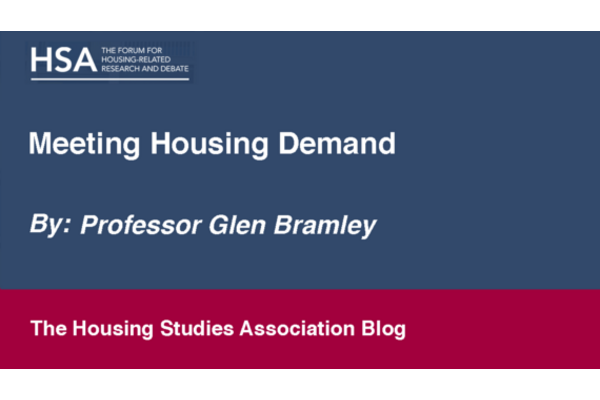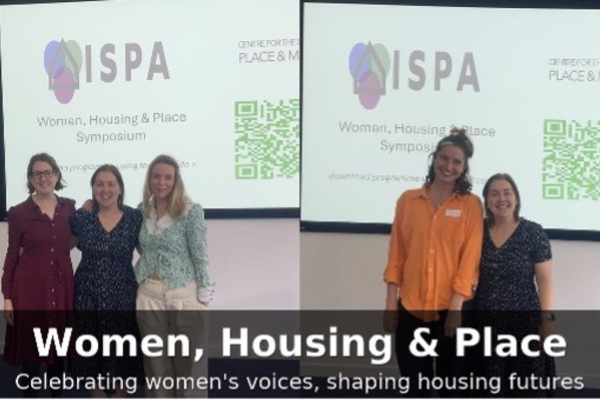Meeting Housing Demand
In this blog Professor, Glen Bramley reflects on decades of parliamentary and governmental inquiries into meeting housing demand and the significance of the latest report from the House of Lords’ Built Environment Committee.
The House of Lords Built Environment Committee recently published a new report on Meeting Housing Demand [1]. Having contributed written evidence to this most recent Inquiry, as well as many other parliamentary or governmental inquiries over several decades, the time feels ripe to step back and share some thoughts on whether and how far the recent report takes us forward.
One way in which we have moved on is that there is much more acceptance, across most of the spectrum, with a few exceptions [2], that we have not been building enough housing in England and that this is socially and economically damaging. Another is that there is growing acceptance that this is not a mono-causal problem, but rather one affected by several contributory factors.
The most important conclusion of this new Parliamentary report is that the Government will not deliver 300,000 homes per year, without removing or reducing several barriers still preventing the meeting of housing demand. Six such barriers are identified in the report. Only one of those is ‘barriers and delays in the planning system’, the usual culprit identified by free-market think-tanks and the housebuilders’ lobby. The other key barriers identified in the report are physical land supply constraints, skill shortages, inadequate resources for local planning authorities, the limited role of small and medium-sized housebuilders, and inadequate support for social housing provision.
If we take the last of these, social housing, the Report is strong in criticising the failure to set a specific target for this form of provision, as well as in criticising the Right to Buy. While noting that any such target would entail a sizeable public subsidy, it balances this with a stinging critique of the waste of subsidy by the Government on the Help to Buy scheme, which throws public money at housebuilder profits to help people who could already afford housing and drives up house prices.
The report is also sound on the generally positive role of planning agreements/obligations (‘Section 106) in supporting the provision of social and other affordable housing in mixed communities, as well as infrastructure costs. While urging improved and more consistent practice, it cautions against the dangers of substituting a system like the Community Infrastructure Levy.
The report rightly highlights the role of limited resources in planning departments to enable them to keep Local Plans up to date and enable the system to create certainty and facilitate orderly development.
On other issues, the report goes most of the way to the right conclusion and then hedges its bets. This is most importantly the case on the key, controversial proposal in the Planning White Paper to have a crude system of ‘zoning’. Under this proposal, in areas identified for development there would be a general presumption in favour of development, so removing local authority power to decide on individual applications on their merits. The Report says that there was a significant volume of evidence which recommended reforms (simplification) of the local plan-making process, but which stopped short of the zoning proposals in the Government’s White Paper. But it then fails to lay it on the line that the Government should not proceed with this particular part of the proposals, even though it is the single biggest source of opposition from most professionals involved.
Similar hedging is apparent on another hardy perennial, the Green Belt. The Conservative Government have a simplistic approach: the Green Belt is sacrosanct; brownfield development is best. This does not accord with professional opinion in planning or the formal purpose of Green Belt, which is as a growth management tool. There are circumstances, particularly around some southern cities with pressured markets where the most appropriate (i.e., sustainable) place to put a significant part of the extra housing needed is on land closely connected to the city which happens to be designated as Green Belt. The report mentions possible land swaps, to maintain the scale of Green Belt while changing its boundary, but it does not sufficiently challenge the basic policy.
While acknowledging that ‘the availability of land is a significant barrier to meeting demand’, and welcoming funding to release brownfield land, it is clear that ‘building on brownfield land is not a “silver bullet”, especially as the availability of brownfield land is disproportionately in areas with less pressure on the housing market’ (para 155). Furthermore, my modelling work suggests that increasing the share of brownfield land reduces completion rates, controlling for other factors [3].
Another form of bypassing planning is the ‘Permitted Development Rights’ scheme under which a lot of substandard housing units have been created by conversion/change of use from commercial premises without any planning control, although the report does recommend ‘monitoring quality’.
There is a large and growing backlog of suppressed new household formation, a growing volume of households (particularly families) in need and/or in unaffordable/insecure private rental housing, and the Government’s approach to setting planning targets to resolve these issues is crude and inadequate. While the report notes that the 2021 Census will provide new data on demographic shifts, including in household formation, it seems to assume that this resolves the fundamental circularity problem with using these as a basis for planning.
The final area where I think the Report highlights a problem but does not get to the real root of it is in its emphasis on the need to bring more Small and Medium-Sized Enterprises into housebuilding. I would reformulate the problem as being one of getting more housebuilding enterprises into the system who are motivated to actually build houses now, rather than sometime in the future, and to build a range of affordable, sustainable products suitable for a wider range of needs. The fix for this problem lies in two steps,
Firstly, give enhanced powers for Local Authorities in growth areas to operate land development agencies, with reserve Compulsory Purchase powers and the ability to buy land at Existing Use Value, to enable funding of all infrastructure before sharing any remaining profit with the original owner.
Secondly, the preferred method of disposal of land for development by such agencies should be auction sale under building licence, subject to planning brief and specified requirements as to phasing and mix, with freeholds conveyed directly to final purchasers. This was the approach generally followed very successfully in the ‘Mark 3’ New Towns (Milton Keynes, Peterborough, etc.) in the 1970s, the last time England saw building in excess of 300,000 houses per year.
[1] See here: House of Lords - Meeting housing demand - Built Environment Committee (parliament. uk)
[2] See original piece by Ian Mulheirn and critical peer review comments by myself and Geoff Meen at Tackling the UK housing crisis: is supply the answer? : CaCHE (housingevidence.ac.uk)
[3] See Table in Bramley, G. (2021) Research on Core Homelessness and Homeless Projections: Technical Report on new baseline estimates and scenario projections. Edinburgh. Heriot-Watt University DOI: 10.17861/fex5-jg80 Appendix D, Table D.1.








